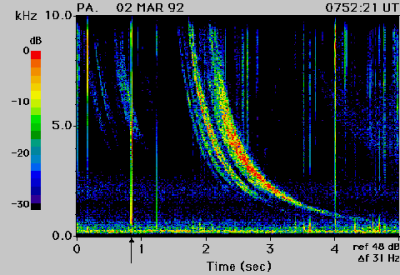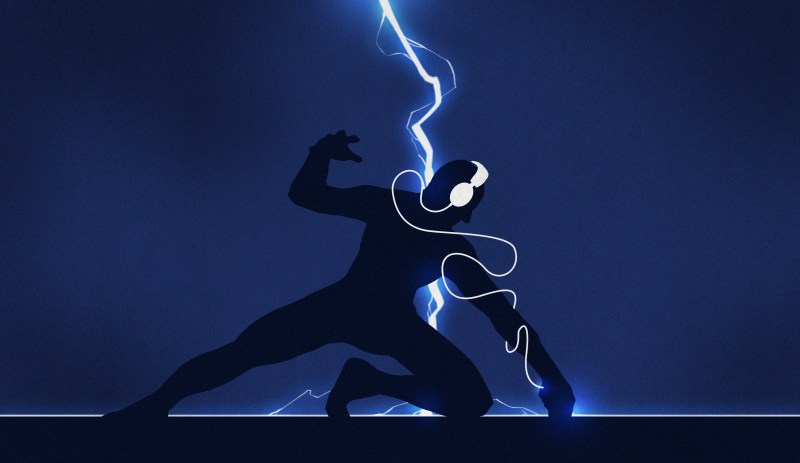We live in an electromagnetic soup, bombarded by wavelengths from DC to daylight and beyond. A lot of it is of our own making, especially further up the spectrum where wavelengths are short enough for the bandwidth needed for things like WiFi and cell phones. But long before humans figured out how to make their own electromagnetic ripples, the Earth was singing songs at the low end of the spectrum. The very low frequency (VLF) band abounds with interesting natural emissions, and listening to these Earth sounds can be quite a treat.
Long, Long Waves
The VLF band is roughly defined as the region of the spectrum from 3 kHz to 30 kHz. The wavelengths are enormous; where the lowest band that most hams operate on has wavelengths of around 160 meters, a 3 kHz signal has a whopping 100 kilometer wavelength. Since the band covers the nominal range of human hearing (20 Hz to 20 kHz), if they were mechanical waves rather than EM waves, they’d be audible.
Such long wavelengths give the VLF band interesting properties, some of which we humans have exploited. VLF waves tend to propagate differently from higher frequency bands. The distance between the Earth and the ionosphere is only a couple of VLF wavelengths high, which forms a waveguide to confine the signals and duct them around the planet. VLF waves also penetrate seawater to some degree, which leads to the primary use of the band: low-bitrate communications with submarines.
But the very characteristics of Earth’s electrical system that make VLF a useful band also gives rise to some really interesting natural VLF signals. The general term for these signals is sferics, from “atmospherics,” and are mostly generated by the 1.3 million lightning bolts discharged into the atmosphere every day. These discharges generate broadband electromagnetic emissions, but due to the electrical and mechanical properties of the discharge, most of the power is radiated in the VLF band. And thanks to the band’s propagation characteristics, that means that with the right equipment you can listen to a thunderstorm on the other side of the planet from you.
What do sferics sound like? Most of us have heard crashes of static on an AM radio during a lightning storm, which is a broadband sferic signal received on a direct path to the lightning bolt. On the VLF band, those same signals sound more like a crackling Geiger counter. If propagation conditions are favorable, a VLF listener can get both the direct path and a path reflected off the ionosphere. The slight time difference between the arrival of the signals makes a pinging sound called a tweek, which sounds to me like hail hitting a metal roof or gutters.

If conditions are right and the lightning bolt discharge occurs with the correct orientation relative to the Earth’s magnetic field, a whistler can result. A whistler is a tone that descends in frequency over a few seconds, sounding just like a whistle that’s fading away. Whistlers are essentially stretched-out tweeks, caused when the VLF signal from a strike travels away from the surface but returns along the Earth’s magnetic field lines, resulting in the dispersion of the signal’s frequency.
The lucky VLF listener may hear the Dawn Chorus. Named after the early morning songbird cacophony, a chorus is a rare event that occurs just before the sun rises at the listening site. It sounds very much like its avian namesake, or parts of the soundtrack of The Birds. It is caused not by lightning strikes but by the solar wind interacting with the magnetosphere.
Gearing Up
Listening in on natural VLF signals doesn’t require especially complex gear, but it does require an understanding of the physics and care for optimizing your setup for the job. This means using a receiver suited to the task, either a commercial rig or something homebrewed, which can be a simple build or a more complex one. Getting past an elevated noise floor caused by the electrical grid is probably the biggest concern, though. Powerline noise and its higher-order harmonics tend to swamp out weak VLF signals, so real Earth Music aficionados go to great lengths to avoid the grid. Putting the receiver as far away from power lines as possible is important. A mile or so from would be best, and some listeners even go so far as to set up solar-powered receivers far out into the wilderness, linking to them with a relay operating on a higher-frequency ham band.
Of course if you just want to poke around on VLF and listen to some of the higher-powered man-made VLF signals, like the aforementioned submarine communications, you can accomplish that with nothing but a hunk of wire attached to the audio input jack of a PC with a decent sound card:
















I imagine there’s fun in listening to your body music as well.
Perhaps for some I guess…
3 octave, 8 second flatus?
“1.3 million lightning bolts discharged into the atmosphere every day”
What an interesting statistic! I had never thought about this before. So that means… that given the current world population of 7,579,367,122 humans… as I just pulled it off of some place called worldometers.info… if each and every one of those lightning bolts scored a lethal hit on a single human being total extinction would take just over 15 years, 11 months and 18 days. If it started right now it would all be over on October 24, 2033.
Well… I guess that implies no births between now and then so that isn’t very accurate. So.. I guess… look up, watch the weather and make lots of babies.
Have a nice day!!
Seems to me you could have run the stats the other way — find out how many people are hit by lightning, and then figure out the hit/miss ratio. Even if 130 people per day are getting hit, which I think (WAG!) is high, thats a 99.99% miss rate. Weaksauce, lightning, weaksauce.
did you factor in to that the average birth and death rate?
Have a look at http://BlitzOrtung.org . It is a very nice project. People listen to lightning strikes and send the time of arrival to a central location which computes the location of the strike. It is worldwide and the time precision (via GPS) is astonishing.
Useful to spark a newbie’s imagination. Jupiter’s is more difficult to receive but has a better show.
True that! I built a Yagi antenna tuned to the hydrogen line (21 cm) just for that purpose a few years back. The Yagi fed into an LNA into a cheap RTL-SDR USB dongle. Fire up GQRX or GnuRadio, set the frequency, and point. Jupiter is crazy loud, and throws off some wild emissions. Kinda like this, but I only used one LNA and got great results. https://hackaday.com/2017/08/02/cascade-lnas-and-filters-for-radioastronomy-with-an-sdr/
Tubular bells holding a morsecode transmission is a really fun fact to know.
Amarok, yes, but Tubular bells? Are you sure?
Awesome!
Would it be a good idea to seed your random number generator with atmospheric noise?
Only if you’re sure the Bad Guys™ don’t know what you are doing and inject a signal…
Use an avalanche diode. Much more reliable. And harder to do bad things to from outside.
Used this technique long long ago to generate one time pad keys for a secure telecommunications device. Ship each pair of devices with the same OTP, off you go. Guaranteed secure. Just don’t a) copy or b) re-use the key.
A friend of mine sent me this link.. prety awesome seeing things embedded in to audio that is not just sound
http://twistedsifter.com/2013/01/hidden-images-embedded-into-songs-spectrographs/
Cool. I heard some VLF tunes a while back but had forgotten. Might be the random element I am missing from some bed tracks.
Nice one
“A hunk of wire” is the name of my new one string quartet.
There’s amateur allocations on 630m (472kHz) and 2200m (135kHz) now. They’ve got rather low power limits and you’re bound to run into tons of interference (especially for the 135kHz one) but there’s hams below 1.8MHz.